Author: Adam Simmons
Date published: September 7th 2023
Table of Contents
Introduction
The combination of 27” screen size and 2560 x 1440 (QHD or 1440p) resolution is very popular for both work and play, with many models offering increased refresh rates to sweeten the deal. The ViewSonic OMNI VX2728J-2K is one such model, with 165Hz+ capability and attractive features such as VRR support and an extended colour gamut. It offers basic HDR support for a different look to things, but this is certainly not a key focus of this screen. We put this model through its paces in our usual testing suite – including gaming, video watching and general desktop usage.
Specifications
The monitor is based on a 27” IPS (In-Plane Switching) type panel from BOE with 2560 x 1440 resolution. A 165Hz+ refresh rate and 10-bit colour are specified. A 2.5ms grey to grey response time is specified, as well as 0.5ms MPRT using the included strobe backlight setting. As usual approach such figures with caution. Some of the key ‘talking points’ for this monitor have been highlighted in blue below, for your reading convenience.
*10-bit can be selected in the graphics driver at up to 120Hz for the native resolution using DP 1.4 under SDR or HDR. 10-bit can be selected at the native resolution up to 60Hz using HDMI 2.0 under SDR or HDR. The bit depths listed here are using a Full Range RGB signal.
**The monitor includes an ‘OverClocking’ feature in the ‘Setup Menu’ section of the OSD. This may or may not work depending on your GPU plus it disables ‘Adaptive-Sync’ regardless of refresh rate selected. In practice it makes minimal real-world difference running at 180Hz vs. 165Hz. We will be including limited testing using this mode but will mainly focus on 165Hz performance. The monitor makes extensive use of matte black plastic, with a relatively slender-legged tripod stand design. The stand base is matte black plastic, whilst the neck is coated metal for a more premium feel than some stands. A small contrasting warm-tone grey ‘OMNI’ logo is printed in the central region of the bottom bezel, for a little visual contrast, with warm-tone white button labels to the right side. The bottom bezel is ~17mm thick with slimmer top and side bezels adopting the popular dual-stage design, with fairly slim panel border flush with the rest of the screen and thin hard plastic outer part. Including both components the bezels are ~9mm (0.35 inches) at the top and sides. The main thing you’ll be paying attention to from the front is the screen itself, which has a medium or ‘relatively light’ matte anti-glare finish as we explore a bit later. The image below is a macro photograph taken on Notepad with ClearType disabled. The letters ‘PCM’ are typed out to help highlight any potential text rendering issues related to unusual subpixel structure, whilst the white space more clearly shows the actual subpixel layout alongside a rough indication of screen surface. This model uses a medium or ‘relatively light’ (slightly lighter than some we’d classify as ‘medium’) matte anti-glare screen surface. The monitor offers good glare handling as it tends to diffuse glare quite heavily, avoiding sharper glare patches and the ‘glassy’ look (in most lighting) that lighter matte and certainly glossy screen surfaces can provide. This also means the image is more likely to become ‘flooded’ or have a hazy appearance due to bright ambient and direct light, so even with the effective glare handling lighting environment needs to be considered. The glare handling is slightly stronger than on 27” OLED gaming monitors we’ve used such as the LG 27GR95QE, yet the screen surface on the ViewSonic has a significantly less grainy appearance and less layering in front of the image. The graininess is what we’d describe as very light and misty in appearance and to most people the screen will appear relatively ‘smooth’ as far as matte surfaces go. This goes to show that screen surfaces are complex 3D structures that can be difficult to categorise in a precise way. The VX2728J-2K features a range of ‘View Mode’ presets; ‘Standard’, ‘FPS Game’, ‘RTS Game’, ‘MOBA Game’, ‘Movie’, ‘Web’, ‘Text’, ‘MAC’ and ‘Mono’. These change various settings and most will lock certain settings off. We ran through these briefly in the OSD video, but for this section will be mainly focusing on other settings and manual adjustments that can be made. The table below shows gamma and white point readings taken using a Datacolor SpyderX Elite colorimeter, alongside general observations by eye. Our test system uses Windows 11 with an Nvidia RTX 3090 connected using a DisplayPort cable. Additional testing was performed via HDMI and also using an AMD Radeon RX 580, though observations on this table didn’t differ significantly between inputs or GPUs. The monitor was left to run for over 2 hours before readings were taken and observations made, without any additional monitor drivers or ICC profiles specifically loaded. Aside from our ‘Test Settings’, where various adjustments were made, assume factory defaults were used with ‘ECO Mode’ set to ‘Standard’. The refresh rate was set to 165Hz in Windows, although this didn’t significantly affect the values or observations in this table. When viewing the figures in this table, note that for most PC users ‘6500K’ for white point and ‘2.2’ for gamma are good targets to aim for. Individual targets depend on individual uses, tastes and the lighting environment, however. Out of the box the monitor provided a vibrant look overall, but there was a cool tint and gamma sagged below the desired ‘2.2’ curve for some shades. This gamma handling is shown in the first image below. On our unit we were able to improve tracking of the ‘2.2’ curve by reducing ‘Black Stabilization’ from the default ‘50’ to ‘30’. Fortunately this setting targets the medium-dark to medium shades where things needed to be tightened up, without significantly affecting very dark or bright shades. And it doesn’t adversely affect contrast, either. This is shown in the second graph, using our ‘Test Settings’. The monitor includes a ‘Blue Light Filter’ LBL setting, which can be set between ‘0’ (disabled) and ‘100’ (maximum reduction). This provides an increasingly warm look to the image due to diminishing the blue colour channel, with the green channel also reduced slightly. Providing a warmer look with visually better balance than some LBL settings which impart an obvious yellowish green tint. We found our eyes adjusted to this change in colour temperature quite readily over time. Reducing brightness further minimises blue light output – and indeed all light output from the monitor. Reducing exposure to blue light can aid viewing comfort, whilst the warmer look to the image can be useful for relaxing viewing. Something that could be particularly beneficial in the hours leading up to sleep. This LBL setting is effective but relatively hard to activate, particularly if wanting to switch between disabling it and the strongest setting (‘Blue Light Filter = 100’) filter as you will need to wait for the monitor to adjust fully up or down with the OSD slider. The ‘Warm’ colour temperature setting was similar to setting the slider to ~80 on our unit and easier to toggle on and off. But it would still be better if it could be assigned to shortcut keys instead of you having to go quite deep into the menu. For our ‘Test Settings’ we significantly reduced brightness and made some tweaks to colour channels. The adjustments here were a bit unconventional – dropping the red channel from ‘100’ to ‘97’ removed a grey neutrality issue (red tint to greys) without significantly affecting the white point. The remaining corrections were to tame the cool and slight green tint our unit had by default. We also reduced ‘Black Stabilization’ to ‘30’, which improved gamma tracking on our unit. Note that individual units and preferences vary, so these settings are simply a suggestion and won’t be optimal for all users or units. We’ve also included the refresh rate used in Windows and our preferred ‘Overdrive’ setting used for most of the review, just for reference. These settings only apply to SDR, HDR has separate settings associated with it (is far more restrictive) and is explored in the relevant section of the review. We used the defaults under HDR. View Mode = Standard Brightness = 46 (according to preferences and lighting) Color Temperature = User Color R = 97 G = 93 B = 90 Black Stabilization = 30 Response Time = Advanced Adaptive-Sync = On [FreeSync Premium] Refresh rate (Windows setting) = 165Hz
As an Amazon Associate and Newegg Affiliate I earn from qualifying purchases made using the below link. Where possible, you’ll be redirected to your nearest store. Further information on supporting our work.
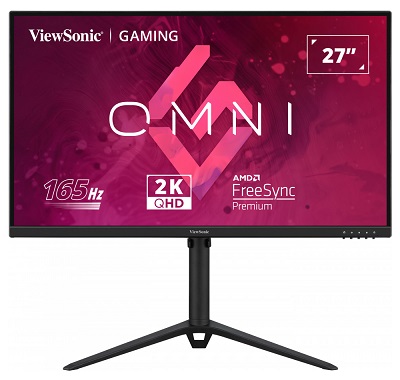
Features and aesthetics


The OSD (On Screen Display) is controlled by buttons beneath the bottom bezel, towards the right side. Button labels (icons) are printed clearly on the bottom bezel. A dedicated power button is also included, with small ‘pin prick’ power LED towards facing forwards towards the right of the power button. This glows blue when the monitor is on and orange when it enters a low power state. The following video runs through the menu system and also explores the changes we made for our ‘Test Settings’, covered later in the review.
The screen is fairly svelte at thinnest point (~10mm or 0.39 inches), bulking out more centrally towards the stand attachment point. This provides tilt (5° forwards, 20° backwards), swivel (30° left, 30° right), height adjustment (130mm or 5.12 inches) and pivot into portrait (90° clockwise rotation). The adjustments felt reasonably smooth, though the monitor sounded slightly creaky when adjusting it. Not as if it was about to fall apart, but not as solid as some models. At lowest stand height the bottom of the screen clears the desk by ~84mm (3.31 inches) with the top of the screen ~445mm (17.52 inches) above the desk. The total depth of the monitor including stand is ~207mm (8.15 inches) with the screen ~30mm (1.18 inches) back from the front edge of the stand base. So quite a compact design in terms of depth – allowing you to place the screen quite close to the wall if you wish, even if your desk isn’t particularly deep.

Black matte plastic dominates at the rear, with contrasting ‘ViewSonic’ lettering in the top central region. The stand attaches centrally via 100 x 100mm VESA and can be removed and replaced with an alternative VESA 100 compatible solution if preferred. An included clip on cable-tidy loop can be attached towards the bottom of the stand neck with additional routing at the bottom of the stand. The ports face downwards and include; DC power input (external ‘power brick’), 2 HDMI 2.0 ports, DP 1.4 and a 3.5mm audio output. A K-slot faces downwards, towards the left side as viewed from the front. 2 x 2W speakers are also included, facing inwards either side of the port area. These offer basic sound output, not particularly bass-rich or high quality with decent but not exceptional maximum volume and a good low minimum volume. Standard accessories include a power cable and “video cable”, with the cables varying regionally.


2560 x 1440 @165Hz plus HDR and Adaptive-Sync can be leveraged via DP 1.4, with HDMI 2.0 also supporting these features but limited to a maximum of 144Hz. AMD FreeSync Premium is supported via DP and HDMI on compatible GPUs and systems with Nvidia’s ‘G-SYNC Compatible Mode’ supported on compatible GPUs via DP. Compatible Intel graphics hardware can also leverage Adaptive-Sync. The monitor runs at up to 180Hz via DP with ‘OverClocking’ enabled, but using this feature disables Adaptive-Sync regardless of the refresh rate you select. AdaptiveSync Display 165 certification is included, meaning the monitor passed specific performance compliance checks when assessed by VESA. The image below shows the refresh rates supported for the native 2560 x 1440 (QHD or 1440p) resolution via DP, with 180Hz also listed via DP if ‘OverClocking’ is used. 144Hz is the maximum supported via HDMI.

The images below show the refresh rates supported when running the 1920 x 1080 (Full HD or 1080p) resolution. The first image shows the resolutions categorised in the EDID of the monitor as ‘TV resolutions’ and listed here under ‘Ultra HD, HD, SD’ and is identical via HDMI. The second image shows resolutions categorised in the EDID and listed here as ‘PC’ resolutions with only 144Hz listed there under HDMI. Note that if ‘OverClocking’ is used 180Hz is also listed there via DP.


If you’re intending to use the monitor with the PS5 or Xbox Series X/S, be aware that a small settings tweak may be required to ensure 120Hz is selectable for supported resolutions. Details can be found in this article. Note that a ‘4k x 2k, 3840 x 2160’ downsampling mode is not included, so the monitor will not accept a 3840 x 2160 (‘4K’ UHD) signal.
Calibration
Subpixel layout and screen surface
![]()
As shown above the standard RGB (Red, Green and Blue) stripe subpixel layout is used. This is the default expected by modern operating systems such as Microsoft Windows. Apple’s MacOS no longer uses subpixel rendering and therefore doesn’t optimise text for one particular subpixel layout to the detriment of another. You needn’t worry about text fringing from non-standard subpixel layouts and won’t need to change the defaults in the ‘ClearType Text Tuner’ as a Windows user. You may still wish to run through the ClearType wizard and adjust according to preferences, however. The subpixel layout and arrangement is normal and we had no subpixel-related concerns related to sharpness or text clarity on this model.
Testing the presets
Monitor Settings Gamma (central average) White point (kelvins) Notes Standard (Factory Defaults) 2.1 7075K A vibrant look overall with cool tint. Some shades too bright due to gamma. Color Temperature = User Color 2.1 6998K As above with slight colour channel balance changes (green slightly too high). Color Temperature = Warm 2.0 5228K An effective Low Blue Light (LBL) setting with greatly reduced blue channel and slightly reduced green channel. The image appears warm without a strong green or yellow tint, your eyes tend to adjust to this quite readily. Blue Light Filter = 100 2.0 4749K As above but stronger effect, with blue channel further minimised. Test Settings (see below) 2.2 6503K Vibrant and well-balanced without cool or green tint and better depth due to gamma handling improvement.
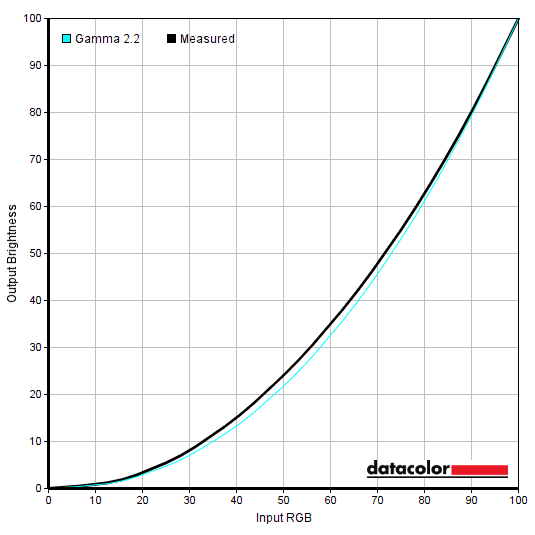
Gamma factory defaults
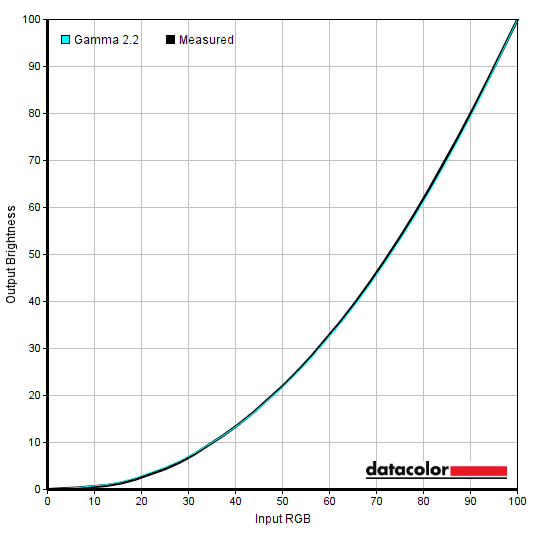
Gamma 'Test Settings'
Given the intended uses for the monitor, inter-unit variation and performance on our unit with OSD tweaking alone we won’t be using any ICC profiles in this review or including any measurements or graphs using them. We wouldn’t recommend using them unless created for your specific unit using your own calibration device. But we appreciate some users still like to use profiles and some aspects such as gamut mapping for colour-aware applications can be useful. You can download our ICC profile for this model, which was created using our ‘Test Settings’ as a base. Note again that this ICC profile isn’t used in the review.
Test Settings
Contrast and brightness
Contrast ratios
An X-Rite i1Display Pro Plus (Calibrite ColorChecker Display Plus) was used to measure the luminance of white and black using various settings, including those found in the calibration section. From these values, static contrast ratios were calculated. The table below shows these results. Blue highlights indicate the results under our ‘Test Settings’ and with HDR active. Black highlights indicate the highest white luminance, lowest black luminance and highest contrast ratio recorded under SDR. Assume any setting not mentioned was left at default, with the exceptions already noted here or in the calibration section.
Measurements using ‘MPRT’ were taken at 165Hz – brightness levels were similar at lower refresh rates, so we didn’t feel it was worthwhile documenting these observations on the table.
| Monitor Settings | White luminance (cd/m²) | Black luminance (cd/m²) | Contrast ratio (x:1) |
| 100% brightness (Factory Defaults) | 261 | 0.27 | 967 |
| 80% brightness | 223 | 0.23 | 970 |
| 60% brightness | 185 | 0.19 | 974 |
| 40% brightness | 145 | 0.15 | 967 |
| 20% brightness | 105 | 0.11 | 955 |
| 0% brightness | 63 | <0.07 | 900 |
| HDR* | 270 | 0.27 | 1000 |
| Color Temperature = User Color | 293 | 0.26 | 1127 |
| Color Temperature = Warm | 236 | 0.26 | 908 |
| Blue Light Filter = 100 | 188 | 0.26 | 723 |
| MPRT = On ('100' brightness) | 192 | 0.2 | 960 |
| MPRT = On ('0' brightness) | 74 | <0.08 | 925 |
| Test Settings | 169 | 0.17 | 994 |
*HDR measurements were made using this YouTube HDR brightness test video, running full screen at ‘1440p HDR’ on Microsoft Edge. The black luminance was measured at the same point of the video as the white luminance and was measured with the colorimeter offset to the side of the white test patch, equidistant between the test patch and edge of the monitor bezel. The monitor doesn’t support local dimming and doesn’t use Dynamic Contrast under HDR, so the patch size and content on the screen more generally doesn’t affect the measured brightness of white.
The average contrast ratio with only brightness adjusted was 955:1, just slightly shy of the specified 1000:1 but within normal range for a model with IPS-type panel. The peak contrast recorded was 1127:1 with colour channels at their neutral position, which is reasonable for the panel type. Under our ‘Test Settings’ we recorded 994:1, which is reasonable given the significant colour channel adjustments made. Lower contrast was measured with the LBL settings, down to 723:1 with the strongest setting. The highest white luminance recorded under SDR was 293 cd/m² (192 cd/m² using ‘MPRT’), whilst the minimum white luminance recorded was 63 cd/m² (74 cd/m² using ‘MPRT’). This provides a luminance adjustment range (without ‘MPRT’) of 230 cd/m² with a reasonably low minimum and reasonable maximum that exceeds the specified value. Under HDR the monitor keeps the backlight at a steady level similar to under SDR with brightness at ‘100’ – we recorded a luminance of 270 cd/m² under HDR with no contrast advantage.
PWM (Pulse Width Modulation)
The VX2728J-2K does not use PWM (Pulse Width Modulation) to regulate backlight brightness at any level. Instead, DC (Direct Current) is used to moderate brightness. The backlight is therefore considered ‘flicker-free’, which will come as welcome news to those sensitive to flickering or worried about side-effects from PWM usage. The exception to this is with ‘MPRT’ active, a strobe backlight setting which causes the backlight to flicker in sync with the refresh rate of the display.
Luminance uniformity
Whilst observing a black background in a dark room, using our ‘Test Settings’, we noticed moderately strong backlight bleed and associated clouding, mainly towards the top right. It’s important to remember that individual units vary when it comes to all aspects of uniformity, including backlight bleed and clouding. The following image was taken a few metres back to eliminate ‘IPS glow’. This was observed as a cool silver or warm and slightly golden haze, depending on angle, which emanates from the corners of the screen. This ‘IPS glow’ blooms out more strongly from steeper angles, as demonstrated in the viewing angles video later. The luminance uniformity was quite poor. The maximum luminance was recorded at ‘quadrant 3’ towards the top right (181.2 cd/m²). The greatest deviation from this occurred at ‘quadrant 7’ towards the bottom left (138.5 cd/m², which is 24% dimmer). The average deviation between each quadrant and the brightest point was 13%, which is fairly high. Remember that individual units vary when it comes to uniformity and you can expect further deviation beyond the points measured. The contour map below shows these deviations graphically, with darker greys representing lower luminance (greater deviation from brightest point) than lighter greys. The percentage deviation between each quadrant and the brightest point recorded is also given. The SpyderX Elite was also used to analyse variation in the colour temperature (white point) for the same 9 quadrants. The deviation between each quadrant and the quadrant closest to the 6500K (D65) daylight white point target was analysed and a DeltaE value assigned. Darker shades are also used on this map to represent greater deviation from 6500K. A DeltaE >3 represents significant deviation that may be readily noticed by eye. Results here were quite good, without significant deviations required. The top central region was recorded as closest to 6500K, with a maximum deviation of DeltaE 2.7 towards the bottom left. Note again that individual units vary when it comes to uniformity and that you can expect deviation beyond the measured points. On Battlefield 2042 the monitor provided a reasonable contrast experience. With contrast coming in at 994:1 under our ‘Test Settings’, there certainly wasn’t a deep and ‘inky’ look to darker shades – but things were as expected for the panel type in that respect. Another typical attribute of IPS-type panels is ‘IPS glow’, a bloom coming from the corners of the screen and generally most noticeable near the bottom corners, with a cool silver to blue tint. This was at a typical level given the panel size and type and it ate away at dark detail – it’s brought out more strongly when using a higher brightness level, if you sit closer to the monitor or if your unit has significant issues with backlight bleed or clouding. The contrast weaknesses are most readily observed in a dim room, so if the room is naturally dim or you prefer muted lighting in the room then consider bias lighting or lighting behind the monitor. This can aid perceived contrast and potentially improve viewing comfort at well. The screen surface provided a reasonably smooth look to brighter shades, very fine ‘misty’ graininess without a clearly layered or smeary appearance. We made similar observations on Shadow of the Tomb Raider. There are many scenes in this title featuring darker areas partially illuminated by small point sources of light. The monitor didn’t provide strong depth or atmosphere to such scenes, with the limited static contrast ratio and ‘IPS glow’ preventing that. This is expected for the panel type, as were the strengths it has when it comes to gamma consistency – applying not just to this game title but anything you do on the monitor. Aside from regions affected by ‘IPS glow’, detail levels are consistently maintained throughout the screen. Without the obvious vertical gradients observed on TN models or masked appearance centrally and potentially excessive detail peripherally observed on VA models. The screen surface again provided less graininess than some matte surfaces. We made further observations on the film Star Wars: The Rise of Skywalker. As with Tomb Raider there are plenty of high contrast scenes – bright energy pulses lighting up darker surroundings and the like. The monitor again failed to provide strong depth here, particularly when observed in a dimly lit room. This was again in-line with expectations for the panel type and due to limited static contrast in addition to ‘IPS glow’ – significant improvements can only be observed with this panel type if a complex FALD backlight solution is employed. Which no directly competing model uses for this sort of price. The film is presented in a ‘letterboxed’ format with black bars above and below the image. The contrast weaknesses are certainly obvious when observing this border, but if the room is well lit these contrast weaknesses are less apparent. Most content streamed on platforms such as Netflix, Disney Plus, Amazon Prime Video and certainly YouTube will be presented in 16:9 without these bars, too. The Lagom tests for contrast allow specific weaknesses in contrast performance to be identified. The following observations were made in a dark room. The colour gamut of the VX2728J-2K is shown as a red triangle below. It was compared with the sRGB (green triangle) and DCI-P3 (blue triangle) reference colour spaces using our ‘Test Settings’, as shown in the first image below. The gamut fully covers sRGB (100%) with significant extension beyond. We recorded 95% DCI-P3 coverage which comfortably exceeds the very conservative 90% DCI-P3 specified by the manufacturer. The exact measured gamut can vary depending on measurement instrument and software, with slight inter-unit variation also possible. You can see significant extension beyond sRGB for green shades and some cyans as well as a bit for the red to blue edge of the gamut. A fair bit of DCI-P3 coverage is missing towards the red corner and the green to red edge, covering pure reds, pinks and purples. Although not shown in the graphic, we recorded 87% Adobe RGB coverage. Although even greater DCI-P3 coverage would be ideal for this, there’s still decent potential for accurate output within the DCI-P3 colour space here. But there’s insufficient Adobe RGB coverage for accurate output within that colour space. For standard sRGB content outside a colour-managed environment, the moderate extension beyond sRGB provides extra saturation and vibrancy without the strongly oversaturated look of models with an even more generous gamut. The monitor doesn’t include an sRGB emulation setting. Setting colour temperature to ‘sRGB’ does not clamp the gamut, the native wide gamut is still used instead. You may try the ICC profile featured in the calibration section which includes gamut mapping for colour-aware applications, but best results are always obtained by calibrating your own unit with your own hardware. Although a well-tuned and flexible sRGB emulation setting is very useful to have, there are GPU level alternatives which can be used instead which will also help for applications that aren’t colour-aware. AMD users can activate a flexible sRGB emulation setting via the graphics driver. This is done by opening ‘AMD Software’, clicking ‘Gaming’ and clicking on ‘Display’. You should then ensure that the ‘Custom Color’ slider to the right is set to ‘Enabled’ and ‘Color Temperature Control’ set to ‘Disabled’. It may appear to be set this way by default, but the native rather than restricted gamut is likely in play. If that’s the case, simply switch the ‘Color Temperature Control’ slider to ‘Enabled’ then back to ‘Disabled’ to leverage the sRGB emulation behaviour. This setting is shown in the image below. The gamut below shows results using our ‘Test Settings’ with this driver tweak applied. The colour gamut now covers 96% sRGB with very little extension beyond. The undercoverage is mainly focused towards the green corner, with this setting offering reasonable sRGB tracking overall. It helps to cut down on the colour gamut without profiling, including in applications that aren’t colour managed. Remember not to use this driver tweak under HDR or the image will appear significantly oversaturated. Whilst Nvidia doesn’t have a similar option in their graphics driver, a third party tool called ‘novideo_srgb’ can be used. This provides a similarly effective GPU-side gamut clamp to the AMD driver option. The resulting gamut was very similar to that shown above with the AMD tweak – this is expected given it uses the same data from the EDID of the monitor. The tool and its usage is covered in our sRGB emulation article. The monitor provided a vibrant look to Battlefield 2042. As with most content observed under SDR, whether gaming or carrying out tasks on the desktop, the developers or creators have the sRGB colour space in mind. If you’re using a gamut on the monitor wider than sRGB, such as using the full native gamut of the VX2728J-2K (95% DCI-P3), things are presented with extra saturation and vibrancy. There’s a bit of a red push which brings out reddish browns slightly too strongly, affecting the neutrality of some earthy and woody brown tones for example. And making some skin tones appear a bit richer than intended. Some yellowish greens are brought out too strongly and some greens appear brighter and less muted than intended, affecting vegetation for example. Sky blues were also shown in a slightly more vivid way than intended. These pushes and the oversaturation observed is not as extreme as on some models with more generous DCI-P3 or indeed Adobe RGB coverage, so the oversaturation isn’t as intense in comparison. The colour experience was similar on Shadow of the Tomb Raider. Earthy browns, some woody tones and Lara Croft’s skin appeared a touch richer than intended with a bit of a red push – though Lara didn’t appear heavily tanned or sunburnt at least. Some vegetation appeared less muted than intended and so did sky blues. Brightly painted red artifacts, purple flowers, greenish yellow citrus fruit and fires had quite a vibrant look – a touch oversaturated, not as heavily as on some models. On both titles and indeed more broadly the strong colour consistency helped ensure vibrancy was well-maintained throughout the screen. Unlike on VA models where there are saturation losses peripherally and TN models where there are clear vertical shifts. We also observed various episodes of the TV series Futurama. As common for animated titles, there are large patches of single shade which help highlight weaknesses in colour consistency very readily. The monitor provided a good experience in this respect, with only minor shifts observed for some shades. Leela’s purple hair, for example, appeared with a very slight extra pink tint peripherally. This was a minor shift, significantly lower than you’d observe on VA or TN models and also lower than some IPS models. The monitor again provided a vibrant look, which certainly suited some of the neon shades on this title such as bright pinks, neon greens and yellows for example. They were less eye-catching than on models with a more generous gamut but more so than standard gamut models. Pastel shades appeared a bit less muted than intended, but there was still strong variety and identity to these shades – the strong colour consistency helped in this respect. The image below shows a printed reference sheet of 24 ‘sRGB’ shades, included as part of the Datacolor SpyderCHECKR 24 package. The screen is displaying reference photographs of this printed sheet, in both the same order as printed (right side) and reverse order (left side). The camera is mounted slightly above centre so that the image is representative of what the eye sees from an ergonomically correct viewing position. This, coupled with the inclusion of a flipped version of the shade sheet, allows both accuracy and colour consistency to be visually assessed. Bracketed numbers in our analysis refer to shades on the printed sheet or right side of the screen if they’re ordered consecutively from top left to bottom right. Note that there is always some disparity between how emissive objects (monitor) and non-emissive objects (printed sheet) appear. The monitor is set to a very low brightness to help minimise this disparity. The representation of shades in this image depends on the camera and your own screen, it’s not designed to show exactly how the shades appear in person. It still helps demonstrate some of the relative differences between the original intended sRGB shade and what the monitor outputs, however. Full profiling and appropriate colour management on the application would provide a tighter match, our intention here is to show what can be expected in a non colour-managed environment. The monitor provides extra vibrancy to many shades due to the generous gamut, with significant extension beyond sRGB in various regions. Avocado (12), dark lime green (18) and yellow green (19) appeared a bit brighter and more saturated due to the gamut, but not with the neon ‘pop’ models with stronger Adobe RGB coverage might show. Persian pink (6), lemon yellow (10) and candy apple red (14) were also brighter and livelier than intended. Light chocolate brown (24) had a mild orangey red push, but not as strong as we sometimes see. Gamboge (23) appeared a bit too much of a mustard yellow without enough of a saffron tint, so slightly overpowered yellows without enough orange for that shade. Colour consistency is strong overall, without the clear saturation shifts observed on VA or TN models depending on the on-screen position of the shade. Slight shifts can be observed mainly for uniformity reasons, for example light chocolate brown (24) has more of the aforementioned orangey red push towards the bottom right. Some discrepancies can be seen for other shades on the photograph, such as medium orange (3), but this was not observed in a clear way by eye and is due to a bit of glare on the screen. It’s very difficult to eliminate this completely whilst also ensuring light levels are suitable to adequately and evenly illuminate the printed sheet. As explored earlier, there’s no sRGB emulation mode on this monitor to explore here. As usual, we’d recommend profiling the monitor with your own colorimeter or spectrophotometer using the native gamut if you require the highest level of colour accuracy. Lagom’s viewing angle tests help explore the idea of colour consistency and viewing angle performance. The following observations were made from a normal viewing position, eyes ~70cm from the screen. Any viewing angle related shifts noted here are more readily apparent if sitting closer and less apparent if sitting further away. On some monitors, particularly but not exclusively those with high refresh rates, interlace patterns can be seen during certain transitions. We refer to these as ‘interlace pattern artifacts’ but some users refer to them as ‘inversion artifacts’ and others as ‘scan lines’. They may appear as an interference pattern, mesh or interlaced lines which break up a given shade into a darker and lighter version of what is intended. They often catch the eye due to their dynamic nature, on models where they manifest themselves in this way. Alternatively, static interlace patterns may be seen with some shades appearing as faint horizontal or vertical bands of a slightly lighter and slightly darker version of the intended shade. We did not observe either artifact type on this monitor. We didn’t observe any static interlace patterns on this model, but we observed dynamic ‘interlace pattern artifacts’ under certain conditions. Fine interlaced vertical lines could be seen during movement or when scanning our eyes across the screen at times. They were reasonably faint at higher refresh rates (e.g. 120Hz+), but stronger at lower refresh rates such as 60Hz. They were observed in a similar fashion regardless of VRR being active and regardless of ‘Response Time’ setting. Not everyone will find them bothersome or necessarily notice them, particularly at higher refresh rates. A sensitive camera and a utility called SMTT 2.0 was used to analyse the latency of the VX2728J-2K. Over 30 repeat readings were taken to help maximise accuracy. Using this method, we calculated 1.95ms (under 1/3 of a frame at 165Hz) of input lag. This figure is influenced by both the element of input lag you ‘see’ (pixel responsiveness) and the main element you ‘feel’ (signal delay). It indicates an exceptionally low signal delay which shouldn’t be bothersome even for sensitive users. Note that we don’t have the means to accurately measure input lag with VRR technology active in a VRR environment or HDR active in an HDR environment. Our article on responsiveness explores various factors affecting monitor responsiveness. A key concept explored is ‘perceived blur’, contributed to by both the pixel responses of the monitor and movement of your eyes as you observe motion on the screen. This second factor dominates on modern monitors, but both factors play an important role. A photography technique called ‘pursuit photography’ is also described, using a moving rather than stationary camera to capture motion on the screen in a way that reflects both parts of perceived blur. Rather than only reflecting the pixel response element. The images below are pursuit photographs taken using the UFO Motion Test for ghosting, with the test running at its default speed of 960 pixels per second. This is a good practical speed to take such photographs at and highlights both elements of perceived blur well. The UFOs move across the screen from left to right at a frame rate matching the refresh rate of the display. All three rows of the test are analysed to highlight a range of pixel transitions. The monitor was tested at 60Hz (directly below), 120Hz, 165Hz and 180Hz* using various ‘Response Time’ settings. Although 144Hz was not documented here, it was tested and performed some way between 120Hz and 165Hz as you might expect. The final column shows the Gigabyte M27Q for reference, an IPS model which provides a decent performance level most are comfortable with. *As noted earlier 180Hz is achieved using the ‘OverClocking’ feature of the OSD, isn’t guaranteed to work with all GPUs and blocks off Adaptive-Sync support. At 60Hz, above, the UFO appears soft and unfocused without clear internal detailing. This reflects a moderate amount of perceived blur due to eye movement. Trailing is observed in places behind the UFO, due to weaknesses in pixel response time or overshoot (inverse ghosting) from aggressive pixel overdrive. With the ‘Standard’ setting there’s a bit of ‘powdery’ trailing with a reasonably bold initial section to the trailing, especially for the dark background (top row) behind the red UFO body. This can be observed to an extent for the medium background (middle row) but is much fainter for the light background (bottom row). The ‘Advanced’ setting as good as eliminates this, but replaces it with some overshoot, mainly ‘halo’ trailing that’s slightly brighter than the background or ‘dirty’ trailing with a slightly inky look due to being a bit darker than the background. This is not extreme overshoot, unlike with the ‘Ultra Fast’ setting. The optimal setting depends on your sensitivity to overshoot. Some will find ‘Advanced’ perfectly usable here as the overshoot isn’t highly eye-catching, but others will prefer the lower acceleration levels of the ‘Standard’ setting. With no real overshoot to speak of and still a pixel response performance that’s slightly superior to the M27Q reference. Below you can see how things appear with refresh rate doubled to 120Hz. At 120Hz, above, the UFO appears significantly narrower with clearer internal detail. This reflects a significant decrease in perceived blur due to eye movement. To the eye the black lines which separate the segments of the UFO are less blended than they appear in the photos at 120Hz and above, so segmentation is more distinct. The pixel response requirements for a good performance here are significantly increased. The ‘Standard’ setting is quite similar to the M27Q reference, slightly stronger in places such as behind the UFO cockpit for the medium background. The ‘Advanced’ setting cuts down the ‘powdery’ trailing quite effectively and introduces a little overshoot – a far from extreme amount. ‘Ultra Fast’ introduces very strong overshoot. We consider ‘Advanced’ optimal here, with ‘Standard’ an option for those who wish to eliminate visible overshoot. Below you can see how things look with a bit of a bump up in refresh rate to 165Hz. At 165Hz, above, the UFO appears a bit narrower with somewhat improved definition. This reflects a further reduction in perceived blur to eye movement, less significant than the initial doubling in refresh rate but an extra 45Hz which is still a significant boost. The black lines and segmentation of the UFO is more distinct than it appears here. The pixel response requirements for a good performance are further increased, so the ‘powdery’ trailing is increased somewhat. The ‘Standard’ setting is similar to the reference screen, slightly faster for the medium background with a less bold initial trail behind the UFO body for example. The ‘Advanced’ setting increases pixel response speed and cuts down on the ‘powdery’ trailing quite effectively, though some certainly still remains. Performance is superior to the reference screen now and there is no observable overshoot for these transitions – the extra 5Hz of the reference screen makes a negligible difference here. The ‘Ultra Fast’ setting again introduces strong and colourful overshoot, so needless to say we consider ‘Advanced’ optimal for 165Hz. Below you can see how things appear with the ‘OverClocking’ feature active and the screen set to 180Hz. The UFOs appear a touch narrower and more sharply focused – with this being just an additional 15Hz the difference isn’t huge. The ‘Advanced’ setting is again optimal here. The reference screen is again shown (at 170Hz) just for easy visual comparison, with the ViewSonic offering superior pixel responses using its optimal ‘Advanced’ setting. The extra 15Hz when accompanied by suitable frame rate also aids connected feel, but as with the perceived blur difference it’s marginal. As well as increasing refresh rate to minimise perceived blur due to eye movement, the monitor offers an alternative in the form of ‘MPRT’. This is a strobe backlight setting that causes the backlight to pulse at a frequency matching the refresh rate of the display (100Hz+). Sensitivity to this flickering varies and some may find it bothersome whilst others will notice accelerated eye fatigue when using the setting, even if the flickering isn’t actively bothersome to them. The pursuit photographs below show the screen running this setting at 100Hz, 120Hz, 144Hz, 165Hz and 180Hz. The ‘Response Time’ setting can be changed, but we set this to ‘Advanced’ for the same reason we would with the setting deactivated. The relative change with each ‘Response Time’ setting is similar with and without ‘MPRT’ active. Unfortunately, the monitor really struggles to make good use of this setting. If you focus on just the main object, you can see arguably more distinct internal detailing and a much narrower appearance to it. But it’s difficult to focus on this as it appears duplicated – this is due to a high level of strobe crosstalk. This forms a repetition of the main object which in this case is nearly as bold as the main object and overlaps it, hampering image clarity. The strobe crosstalk can appear differently depending on how far up or down the screen you’re observing, but all UFOs are shown roughly in the central region here (the middle row is the centre) and it’s still very strong – particularly for the dark and medium backgrounds. This is the case regardless of refresh rate, with increasing refresh rate making the strobe crosstalk fragment stick closer to the object, but still not removing the overlap either way. This strong central strobe crosstalk is problematic because it’s the region of the screen where your eyes spend most of their time focusing in the sort of competitive titles this setting is primarily designed for. The weaknesses were sufficient to be both distracting and uncomfortable and really detracted from the purpose of this setting for us when gaming. We don’t feel this setting will appeal to most users, even if they usually like to use this sort of setting. For these reasons we won’t be performing further assessment of this setting. On various Battlefield titles, with the frame rate keeping pace with the 165Hz refresh rate, the monitor provided good fluidity. The monitor can output up to 2.75 times as much visual information per second as a 60Hz monitor (or this one running at 60Hz / 60fps). This significantly improves the ‘connected feel’, describing the precision and fluidity felt when interacting with the game. This ‘connected feel’ is also aided by the exceptionally low signal delay of the screen. The high frame and refresh rate combination has benefits elsewhere, reducing perceived blur due to eye movement – something demonstrated earlier using Test UFO. This makes it easier to keep track of enemies during firefights, for example, which provides a nice competitive edge. It can also make the experience more pleasant even for casual gaming or simply general desktop usage of the monitor. It’s also important to consider pixel responsiveness, another area of perceived blur. As covered earlier with Test UFO, this monitor performs quite well in that respect – this is observed over a broader range of transitions when gaming, too. Using our preferred ‘Advanced’ setting there was little to complain about in the way of overshoot, very slight traces in places but well-blended and not something most would be able to clearly see even if looking out for it. There was a touch of ‘powdery’ trailing, strongest where bright or strongly saturated shades were set against a contrasting background. And to a lesser extent where dark shades were set against a contrasting background, such as a dark tree trunk against the sky. Even where the weaknesses were most readily observed, they were still fairly minor – very different to the more pronounced weaknesses observed on most VA models and also some IPS offerings. We made similar observations on Shadow of the Tomb Raider. There are plenty of scenes here which involve mixtures of bright and much darker shade, such as caves with a little light coming in from outside or from torches. This showcased the weakest pixel transitions performed by the monitor, but even then the ‘powdery’ trailing stuck quite close to the object. It was not ‘smeary’ in appearance or as bold as on even some IPS models let alone most VA models. There was no real overshoot to speak of, again small traces for some transitions but nothing we found remotely eye-catching. We also observed video content at a range of refresh rates, including ~24 – 30fps content on platforms such as Netflix, Disney Plus and Amazon Prime Video as well as 60fps content on YouTube. There were no real weaknesses from the pixel responses of the monitor, with the main barrier to fluidity being the frame rate of the content itself. As an Amazon Associate and Newegg Affiliate I earn from qualifying purchases made using the below link. Where possible, you’ll be redirected to your nearest store. Further information on supporting our work. AMD FreeSync is a variable refresh rate technology, an AMD-specific alternative to Nvidia G-SYNC. Where possible, the monitor dynamically adjusts its refresh rate so that it matches the frame rate being outputted by the GPU. Both our responsiveness article and the G-SYNC article linked to explore the importance of these two elements being synchronised. At a basic level, a mismatch between the frame rate and refresh rate can cause stuttering (VSync on) or tearing and juddering (VSync off). FreeSync also boasts reduced latency compared to running with VSync enabled, in the variable frame rate environment in which it operates. FreeSync requires a compatible AMD GPU such as the Radeon RX 580 used in our test system. The monitor itself must support ‘VESA Adaptive-Sync’ for at least one of its display connectors, as this is the protocol that FreeSync uses. The VX2728J-2K supports FreeSync Premium via DP and HDMI on compatible GPUs and systems. Note that HDR can be activated at the same time as FreeSync. You need to make sure ‘Adaptive-Sync’ is set to ‘On [FreeSync Premium]’ in the ‘Setup Menu’ section of the OSD. You should also ensure the GPU driver is setup correctly to use FreeSync – so open ‘AMD Software’, click ‘Gaming’ and click on ‘Display’. You should then ensure that the first slider is set to ‘Enabled’ as shown below. The top image shows the monitor connected by DP and the bottom image by HDMI. The setting is referred to as ‘AMD FreeSync’ via DP and ‘VRR’ via HDMI, although the exact wording may depend on the driver version you’re using. To configure VSync, open ‘AMD Software’. Click ‘Gaming’ and click ‘Graphics’. The setting is listed as ‘Wait for Vertical Refresh’. This configures it globally, but if you wish to configure it for individual games click ‘Game Graphics’ towards the top right. The default is ‘Off, unless application specifies’ which means that VSync will only be active if you enable it within the game itself, if there is such an option. Such an option does usually exist – it may be called ‘sync every frame’ or something along those lines rather than simply ‘VSync’. Most users will probably wish to enable VSync when using FreeSync to ensure that they don’t get any tearing. You’d therefore select either the third or fourth option in the list, shown in the image below. Above this dropdown list there’s a toggle for ‘Radeon Enhanced Sync’. This is an alternative to VSync which allows the frame rate to rise above the refresh rate (no VSync latency penalty) whilst potentially keeping the experience free from tearing or juddering. This requires that the frame rate comfortably exceeds the refresh rate, not just peaks slightly above it. We won’t be going into this in detail as it’s a GPU feature rather than a monitor feature. As usual we tested various game titles using AMD FreeSync and found the experience very similar in all cases. Issues affecting one title but not others would suggest a problem with the game or GPU driver rather than the monitor. We’ll just focus on Battlefield titles here, for simplicity. These titles provide a suitable range of graphics options to allow the full VRR range to be assessed with our Radeon RX 580. This isn’t a powerful GPU, so dips below 165fps are common – even with greatly reduced graphics settings. Without the technology active you can observe tearing (VSync off) or stuttering (VSync on) due to the frame and refresh rate being out of sync. Enabling FreeSync resolves this and is certainly a nice thing to have active if you’re sensitive to tearing or stuttering. It doesn’t make low frame rates feel like high frame rates, though, so it’s still beneficial in terms of perceived blur levels and ‘connected feel’ to have a high frame rate where possible. The monitor doesn’t use tightly tuned variable overdrive, which would carefully re-tune the pixel overdrive and significantly slacken off acceleration levels as refresh rate drops to minimise overshoot. Using the setting we prefer for higher refresh rates, ‘Advanced’, there’s an increasing level of overshoot as refresh rate drops. However; it isn’t an extreme amount of additional overshoot and even down to ~60Hz it isn’t as eye-catching as it is on some models. Some people may wish to simply use the ‘Advanced’ setting throughout the VRR range and could consider this a single overdrive mode experience. Others may prefer switching to the ‘Standard’ setting, which eliminates the overshoot and provides a touch more ‘powdery’ trailing – but still offers a competent performance for these relatively low refresh rates. FreeSync worked down to the floor of operation of ~55Hz (55fps), below which LFC (Low Framerate Compensation) kicked in. LFC keeps the refresh rate at a multiple of the frame rate to keep tearing and stuttering at bay. There was a subtle momentary stuttering when LFC activated or deactivated, something we always observe and not specific to this model. It was much less noticeable than traditional stuttering from frame and refresh rate mismatches, but if you’re sensitive to it and frequently passing the boundary it could be annoying. As noted earlier, AMD FreeSync makes use of Adaptive-Sync technology on a compatible monitor. As of driver version 417.71, users with Nvidia GPUs (GTX 10 series and newer) and Windows 10 or later can also make use of this Variable Refresh Rate (VRR) technology. When a monitor is used in this way, it is something which Nvidia refers to as ‘G-SYNC Compatible’. Some models are validated as G-SYNC compatible, which means they have been specifically tested by Nvidia and pass certain quality checks. With the VX2728J-2K you need to connect the monitor up via DP to use ‘G-SYNC Compatible Mode’. You also need to make sure ‘Adaptive-Sync’ is set to ‘On [FreeSync Premium]’ in the ‘Gaming’ section of the OSD. When you open up Nvidia Control Panel, you should then see ‘Set up G-SYNC’ listed in the ‘Display’ section. Ensure the ‘Enable G-SYNC, G-SYNC Compatible’ checkbox and ‘Enable settings for the selected display model’ is checked as shown below and press ‘OK’. If you’ve enabled ‘G-SYNC Compatible’ and it was previously disabled, the monitor should re-establish its connection with the system and the technology should now be active. HDR (High Dynamic Range) on an ideal monitor involves very deep dark shades and brilliantly bright light shades being displayed simultaneously. As well as a broad range of shades between these extremes, including muted pastel shades alongside vivid and strongly saturated shades. Ideally, per-pixel illumination would be provided (e.g. self-emissive displays such as OLED), or for LCDs a very large number of precisely controlled dimming zones used. A solution such as FALD (Full Array Local Dimming) with a generous number of dimming zones, for example. Such a solution would allow some areas of the screen to remain very dim whilst others show brilliantly high brightness. Colour reproduction is also an important part of HDR, with the ultimate goal being support for a huge colour gamut, Rec. 2020. A more achievable near-term goal is support for at least 90% DCI-P3 (Digital Cinema Initiatives standard colour space) coverage. Finally, HDR makes use of at least 10-bit precision per colour channel, so its desirable that the monitor supports at least 10-bits per subpixel. HDR10 is the most widely supported standard used in HDR games and movies and what is supported here. For games and other full screen applications that support HDR, the VX2728J-2K automatically switches to its HDR operating mode if an HDR signal is provided and ‘HDR’ is set to ‘On’ in the ‘Setup Menu’ section of the OSD. Some game titles will activate HDR correctly when the appropriate in-game setting is selected. Others that support HDR will only run in HDR if ‘Use HDR’ is turned on in Windows, too. Related Windows HDR settings are found in the ‘Windows HD Color settings’ (Windows 10) or ‘HDR’ (Windows 11) section of ‘Display settings’ (right click the desktop). If you want to view HDR movie content, ensure ‘Stream HDR Video’ (Windows 10) or ‘Play streaming HDR video’ (Windows 11) is active. Also note that there’s an ‘HDR/SDR brightness balance’ (Windows 10) or ‘SDR content brightness’ (Windows 11) slider that allows you to adjust the overall balance of SDR content if HDR is active in Windows. This is really just a digital brightness slider that only makes changes for SDR content, and you lose contrast by adjusting it. The settings in the OSD are greatly restricted under HDR and the gamma and general balance to the image is off when viewing SDR content, with things appearing more muted and unintended dark detail revealed for example. So we’d only recommend activating HDR in Windows if you’re about to use an HDR application that specifically requires it. For simplicity we’ll focus primarily on Shadow of the Tomb Raider here. We’ve tested this title on a wide variety of monitors under HDR and we know it features a good HDR implementation which tests the hardware capabilities of the monitor appropriately. Although our testing focuses on HDR PC gaming with an RTX 3090 connected using DP, similar observations were made when viewing HDR video content on the Netflix app. There are some additional points to bear in mind if you wish to view such content. We also made similar observations using HDMI, which would be used when viewing HDR content on an HDR compatible games console for example. Testing on both our Nvidia and AMD GPUs provided a similar experience, via both DP and HDMI. The usual settings you’d see under SDR such as brightness, contrast, sharpness and ‘Colour Temperature’ can’t be adjusted under HDR. A mild sharpness filter is applied under HDR which you can’t disable, but this isn’t strong enough to give a clear artificially oversharpened look. You can adjust ‘Response Time’ under HDR. You will need to switch ‘HDR’ back to ‘Off’ under SDR to regain these controls and some others which are locked off, which is an annoying an unnecessary restriction. The monitor does at least remember the settings you were using when last using SDR, even if these adjustments are locked off. The VX2728J-2K doesn’t include even the lowest level of VESA DisplayHDR certification (VESA DisplayHDR 400) – though even if it were certified at that trier, it indicates only a basic HDR experience is provided. We measured a colour gamut of 95% DCI-P3, shown in the representation below. The red triangle shows the monitor’s colour gamut, the blue triangle DCI-P3 and green triangle sRGB. This gamut allows for a reasonable level of vibrancy under HDR, with some reasonably rich-looking greens of vegetation (a bit less vibrant than we’d expect given the gamut) and some fairly eye-catching bright red berries, purple flowers and painted artifacts for example. More generous Rec. 2020 coverage (more coverage of and extension beyond DCI-P3) and superior dimming precision would help add extra depth and saturation. Because game developers have extended colour spaces beyond sRGB (namely DCI-P3 and Rec. 2020) in mind, you don’t observe the same oversaturation that you do when using the native gamut of the monitor under SDR. The red push to some wood tones, skin tones and earthy browns were toned down for example. And some green shades which appeared slightly too eye-catching or bright under SDR appeared more appropriately muted under HDR. This scene highlighted some advantage from the 10-bit precision, but for both the bright and dark shades there was a definite lack of shade variety. This was linked to the backlight being controlled as a single unit without local dimming, so there is no contrast advantage under HDR. This distinguishes it from a ‘true’ HDR experience where strong contrast is a key aspect. The monitor doesn’t employ Dynamic Contrast under HDR, it simply sticks to its maximum brightness level (270 nits as recorded earlier). The result is a definite lack of depth to shadow details and even many of the medium shades here are lacking the depth they should have as a result. When considering darker scenes than this, they simply lack any semblance of depth or atmosphere which really breaks the immersion there and separates this from a true HDR experience. The brightness is also too limited for bright elements to stand out appropriately or for there to be sufficient dynamic range there to truly demonstrate the 10-bit advantages. This is a very rudimentary HDR experience, far removed from a ‘proper’ HDR experience – it gives a different look to things and can be used for a bit of variety, but it isn’t something you’ll want to use all the time. The section of video review below runs through the HDR experience using various scenes from Shadow of the Tomb Raider. It may be desirable or indeed necessary to run the monitor below its native 2560 x 1440 (QHD or 1440p) resolution. This could be for performance reasons or because you’re using a system (such as a games console) that doesn’t support a QHD signal. The monitor provides scaling functionality via both DP and HDMI. It can be run at resolutions such as 1920 x 1080 (Full HD) and can use an interpolation (scaling) process to map the image onto all pixels of the screen. This is supported for refresh rates listed in the first list (‘Ultra HD, HD, SD’) in the ‘Features and aesthetics’ section, so up to 120Hz. To ensure the monitor rather than GPU is handling the scaling process, as a PC user, you need to ensure the GPU driver is correctly configured so that the GPU doesn’t take over the scaling process. For AMD GPU users, the driver is set up correctly by default to allow the monitor to interpolate where possible. Nvidia users should open Nvidia Control Panel and navigate to ‘Display – Adjust desktop size and position’. Ensure that ‘No Scaling’ is selected and ‘Perform scaling on:’ is set to ‘Display’ as shown in the following image. As usual, if you’re running the monitor at 2560 x 1440 and viewing 1920 x 1080 content (for example a video over the internet or a Blu-ray, using movie software) then it is the GPU and software that handles the upscaling. That’s got nothing to do with the monitor itself – there is a little bit of softening to the image compared to viewing such content on a native Full HD monitor, but it’s not extreme and shouldn’t bother most users. The video below shows the monitor in action. The camera, processing done and your own screen all affect the output – so it doesn’t accurately represent what you’d see when viewing the monitor in person. It still provides useful visual demonstrations and explanations which help reinforce some of the key points raised in the written piece. The ViewSonic OMNI VX2728J-2K provides the popular combination of 27” screen size, QHD resolution and 165Hz+ refresh rate. A good amount of ‘desktop real estate’ and respectable pixel density for both work and play is provided here. The screen offers decent build quality for a budget offering, with coated metal included for the stand neck, with fully adjustable stand providing good ergonomics. The monitor includes a basic array of ports, without USB of any variety for example, but squeezes in basic integrated speakers for convenience. The OSD includes the usual essentials plus a few not always found on monitors such as a sharpness control and integrated crosshair plus well-tuned ‘Black Stabilization’ setting. This proved useful as there were no alternative gamma settings in the OSD. Also absent was an integrated on-screen frame counter (refresh rate display) and flexible shortcut system, whilst we prefer joysticks for intuitive navigation through OSDs. The monitor provided good colour consistency, in-line with other good IPS performers, though viewing angle performance for off-angle viewing was weaker than some IPS models. A generous colour gamut was provided, exceeding the specified 90% DCI-P3 with 95% recorded. This provided a vibrant look and good potential for work within both the sRGB and DCI-P3 colour spaces. A notable omission was any form of sRGB emulation setting, however. Contrast fell in line with expectation, slightly exceeding the specified 1000:1 or very close to it depending on settings used. The level of ‘IPS glow’ was also as expected, though our unit suffered from a moderately high level of backlight bleed which brought this out more strongly in places. The brightness adjustment range was decent though not outstanding, with a maximum a bit beyond specified, and basic HDR support was offered for ‘a bit of variety’. We stress the basic, though, as brightness capability and lack of local dimming severely handicapped this setting. The requirement to manually activate it and deactivate it in the OSD (if you want full setting availability under SDR) was also an odd quirk. In terms of responsiveness the monitor provided a competent 165Hz performance with exceptionally low input lag. It also has the ability to run at 180Hz via an integrated overclocking feature (GPU dependent) but doing so disabled Adaptive-Sync. Most will want to stick to 165Hz (which isn’t dramatically different to 180Hz) with VRR instead. The monitor provided a solid AMD FreeSync and Nvidia ‘G-SYNC Compatible’ experience and for many this will be a ‘single overdrive mode experience’. The ‘Advanced’ setting is free from strong overshoot throughout the refresh rate range, which was nice to see particularly on a budget offering. The monitor included an ‘MPRT’ strobe backlight setting, but this can’t be used alongside VRR and was poorly tuned with significant strobe crosstalk. Overall, we feel this is a capable monitor for a very attractive price and it sits well and, in some ways, stands out amongst its peers. If you require a more generous gamut including very strong Adobe RGB and DCI-P3 coverage either due to the strong hit of extra vibrancy or for colour-accurate work within those spaces, the MSI MAG274QRF-QD would be a good alternative to consider. This model also provides emulation for multiple colour spaces, higher brightness output and slightly stronger contrast. It comes at a significant price premium, so if you’re sticking to a tighter budget and can live without these features then the ViewSonic is worth careful consideration. As an Amazon Associate and Newegg Affiliate I earn from qualifying purchases made using the below link. Where possible, you’ll be redirected to your nearest store. Further information on supporting our work.

The SpyderX Elite was used to assess the uniformity of lighter shades, represented by 9 equally spaced white quadrants running from the top left to bottom right of the screen. The table below shows the luminance recorded at each quadrant as well as the percentage deviation between each quadrant and the brightest recorded point.

Luminance uniformity table
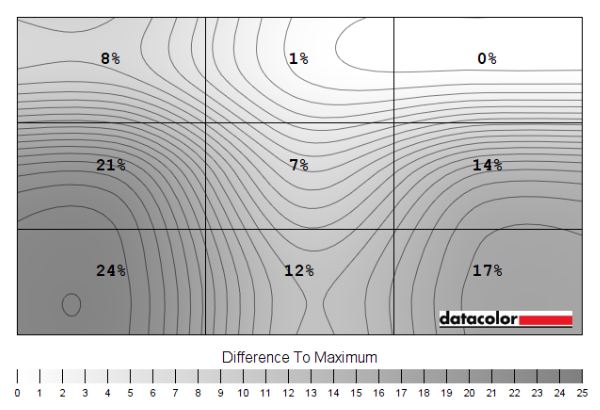
Luminance uniformity map
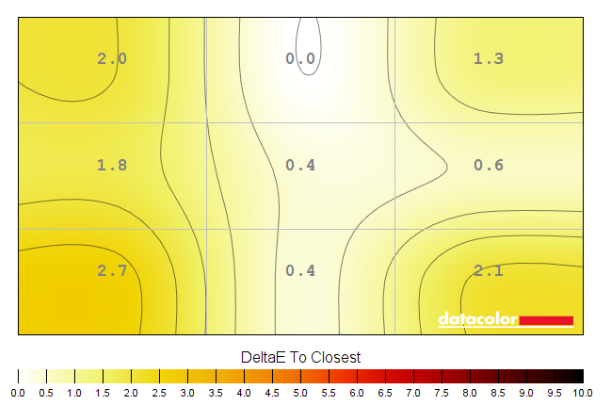
Colour temperature uniformity map
Contrast in games and movies
Lagom contrast tests
Colour reproduction
Colour gamut
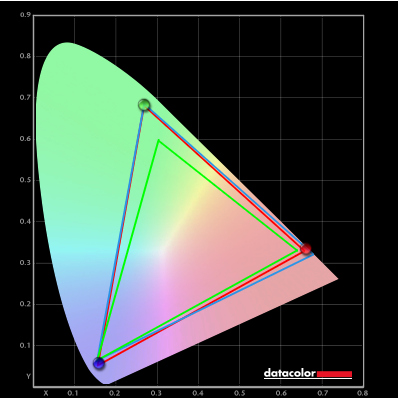
Colour gamut 'Test Settings'
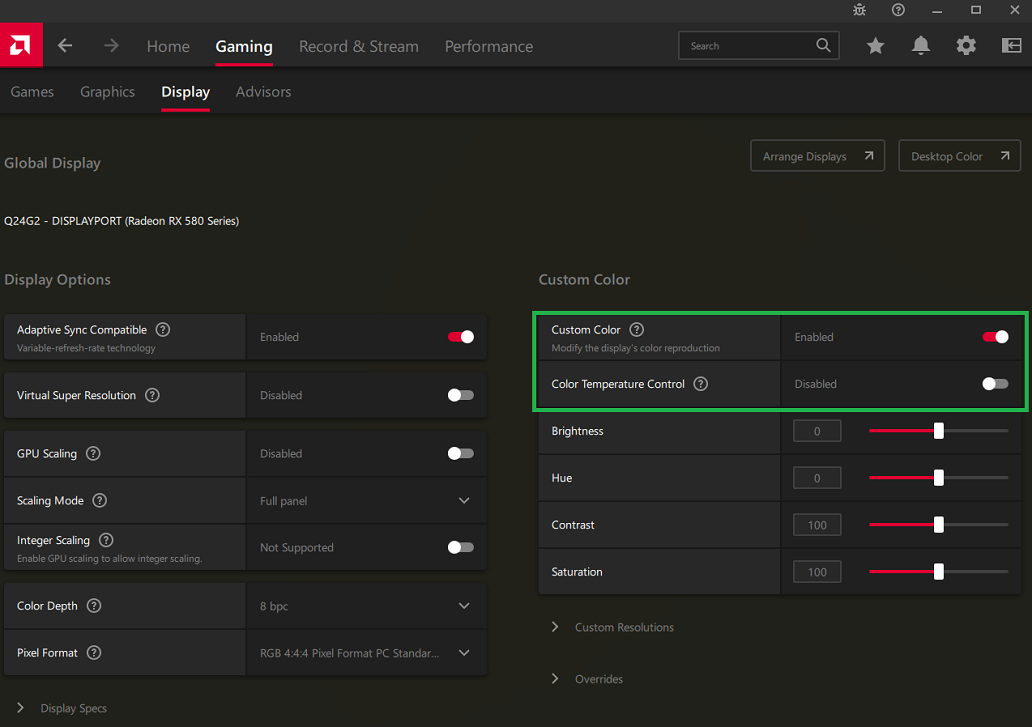
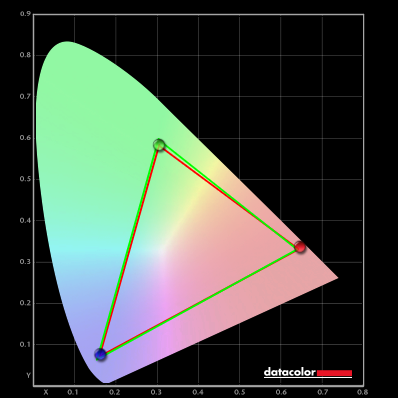
Colour gamut AMD 'CTC disabled' setting
Colour in games and movies
Shade representation using SpyderCHECKR 24

Viewing angles

The video below shows the Lagom text test, a mixed desktop background, game scene and dark desktop background from various viewing angles. The colour shifts for the mixed desktop background and game scene are relatively minor, significantly lower than you’d observe on VA or TN models. There’s some ‘hazing’ (contrast loss) from sharper angles, which is more noticeable than on some IPS models and kicks in a bit sooner. The dark desktop background highlights ‘IPS glow’, which blooms out as viewing angle increases. This appears as a cool silver or slightly golden shade, depending on angle.
Interlace pattern artifacts
Responsiveness
Input lag
Perceived blur (pursuit photography)





Responsiveness in games and movies

VRR (Variable Refresh Rate) technology
FreeSync – the technology and activating it


The ViewSonic supports a variable refresh rate range of 48 – 165Hz (48 – 144Hz via HDMI). That means that if the game is running between 48fps and 165fps (for DP), the monitor will adjust its refresh rate to match. When the frame rate rises above 165fps, the monitor will stay at 165Hz and the GPU will respect your selection of ‘VSync on’ or ‘VSync off’ in the graphics driver. With ‘VSync on’ the frame rate will not be allowed to rise above 165fps, at which point VSync activates and imposes the usual associated latency penalty. With ‘VSync off’ the frame rate is free to climb as high as the GPU will output (potentially >165fps). AMD LFC (Low Framerate Compensation) is also supported by this model, which means that the refresh rate will stick to multiples of the frame rate where it falls below the 48Hz (48fps) floor of operation for FreeSync. If a game ran at 40fps, for example, the refresh rate would be 80Hz to help keep tearing and stuttering at bay. LFC usually activated at a slightly higher refresh rate of 55Hz or just slightly below – this slightly different floor of operation makes little difference in practice. This feature is used regardless of VSync setting, so it’s only above the ceiling of operation where the VSync setting makes a difference.

Some users prefer to leave VSync enabled but use a frame rate limiter set a few frames below the maximum supported (e.g. 162fps) instead, avoiding any VSync latency penalty at frame rates near the ceiling of operation or tearing from frame rates rising above the refresh rate. If you go to ‘Setup Menu’ – ‘Information’ in the OSD, the current refresh rate of the monitor is listed. This updates in real time and will reflect the frame rate of the content, if the monitor is within the main VRR window. Finally, it’s worth noting that FreeSync only removes stuttering or juddering related to mismatches between frame rate and refresh rate. It can’t compensate for other interruptions to smooth game play, for example network latency or insufficient system memory. Some game engines will also show stuttering (or ‘hitching’) for various other reasons which won’t be eliminated by the technology.
FreeSync – the experience
Nvidia Adaptive-Sync (‘G-SYNC Compatible’)

You will also see in the image above that it states: “Selected Display is not validated as G-SYNC Compatible.” This means Nvidia hasn’t specifically tested and validated the display, not that it won’t work. On our RTX 3090 the experience was very similar to what we described with FreeSync. With the technology getting rid of tearing and stuttering from what would otherwise be frame and refresh rate mismatches, within the VRR range of ~55 – 165Hz. An LFC-like frame to refresh multiplication technology was employed below that to keep tearing and stuttering from frame and refresh rate mismatches at bay. There was again a subtle momentary stuttering as the boundary was crossed, as we observed with our AMD GPU as well. Our suggestions regarding use of VSync also apply, but you’re using Nvidia Control Panel rather than AMD Software to control this. The setting is found in ‘Manage 3D settings’ under ‘Vertical sync’, where the final option (‘Fast’) is equivalent to AMD’s ‘Enhanced Sync’ setting. You’ll also notice ‘G-SYNC Compatible’ listed under ‘Monitor Technology’ in this section, as shown below. Make sure this is selected (it should be if you’ve set everything up correctly in ‘Set up G-SYNC’).
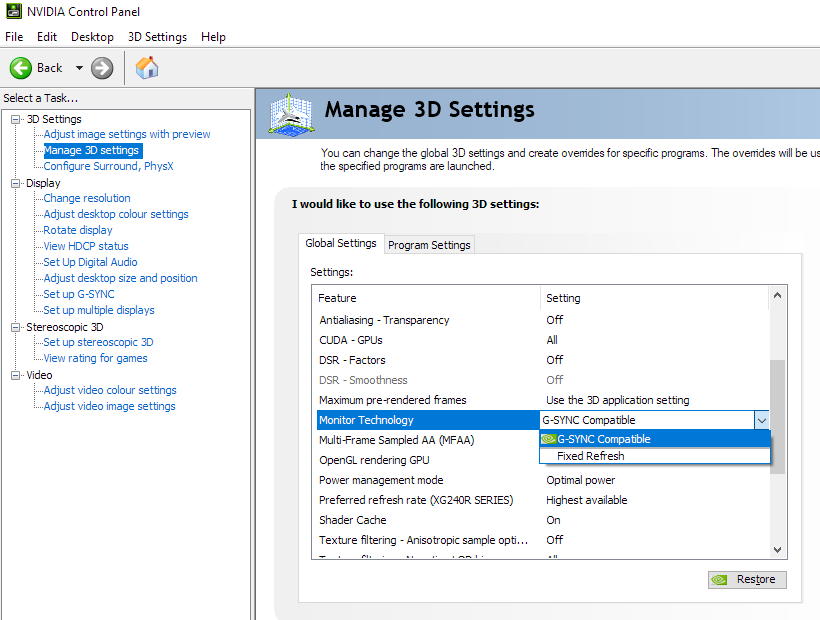
If you go to ‘Support’ – ‘Information’ in the OSD, the current refresh rate of the monitor is listed. This updates in real time and will reflect the frame rate of the content, if the monitor is within the main VRR window. And as with AMD FreeSync, HDR can be used at the same time as ‘G-SYNC Compatible’.
HDR (High Dynamic Range)
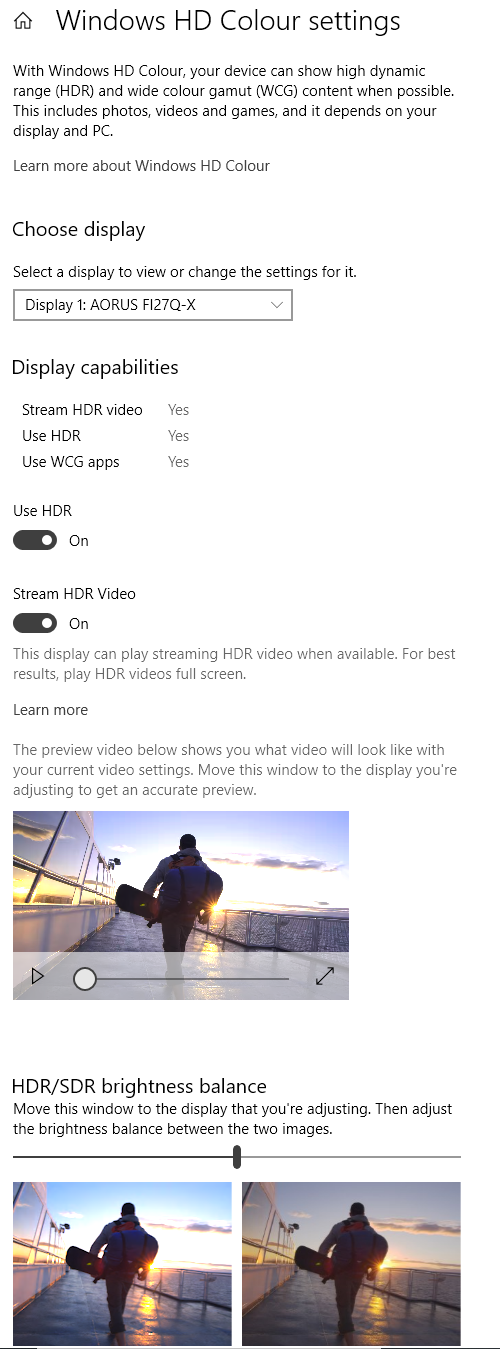
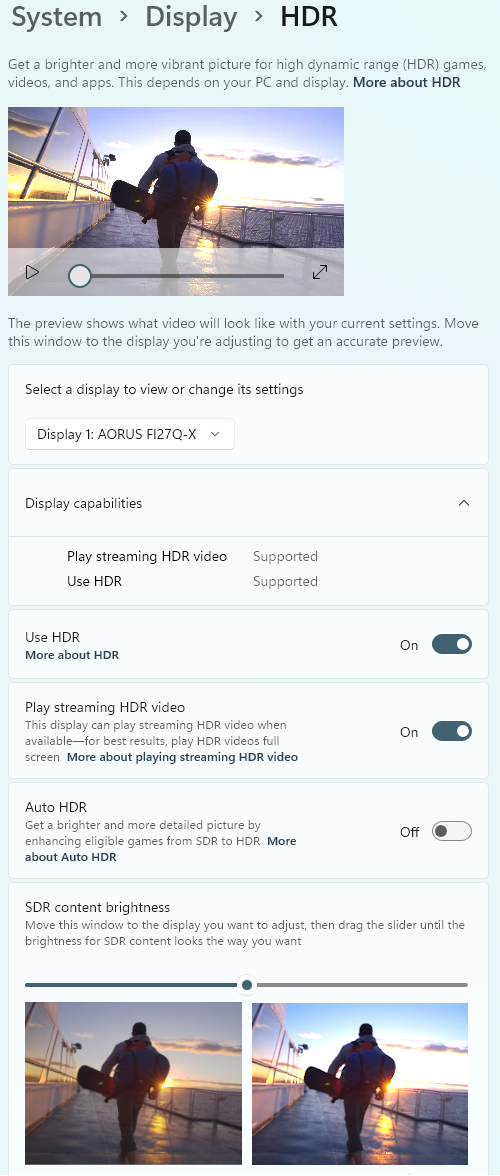

Colour gamut 'Test Settings'
The monitor also supports 10-bit colour, which can be used efficiently for HDR10 content like this to facilitate enhanced luminance and shade mapping precision expected under HDR. Though in this case, it’s purely related to shade mapping due to the universal dimming of the backlight. This is handled with monitor dithering up to 120Hz (up to 60Hz via HDMI) via the native resolution. For higher refresh rates the GPU adds a dithering stage. We’ve carefully observed a range of content, including fine gradients, on a broad range of monitors where 10-bit is supported monitor side (usually 8-bit + FRC) and where the GPU handles the dithering under HDR. Including comparisons with a given model where the monitor handles the dithering at some refresh rates and the GPU handles it at others. Regardless of how ’10-bit’ is achieved, the resulting image is essentially identical. 10-bit colour helps the monitor put its wide gamut to good use and also enhances the nuanced shade variety. When observing dark shades, for example, the improved nauanced shade variety helps give a natural uplift of detail. This is preferable to the artificial lightening of dark shades that can achieved under SDR using a gamma enhancement. For bright shades the enhanced variety smooths out gradients and allows for more natural shade progressions for weather and particle effects, for example. To help accentuate these advantages, the monitor would need a good level of dimming precision on the backlight and that simply isn’t offered here. The image below shows one of the scenes we particularly like from Shadow of the Tomb Raider under HDR. Remember that the photo is purely for illustrative purposes and in no way represents how the monitor appeared running HDR in person.

Interpolation and upscaling
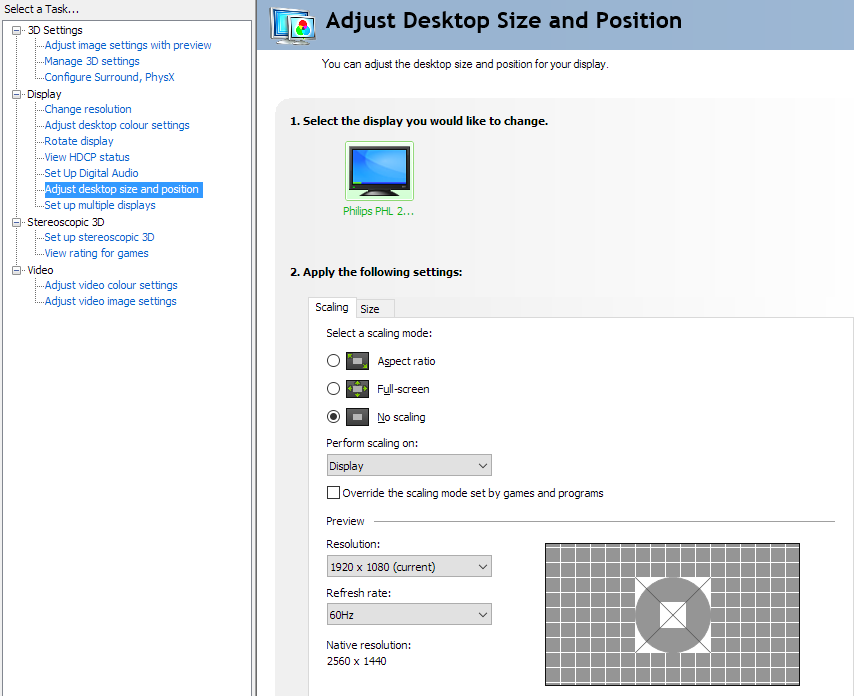
The monitor includes a few ‘Aspect Ratio’ settings which will adjust the image to suit various different resolutions – you can also select a different aspect ratio to the resolution selected to ‘emulate’ that experience. You can select 4:3, 5:4, 16:9 or 16:10. Using the default 16:9 setting and running the monitor at 1920 x 1080 (Full HD or 1080p), the interpolation process provides moderate but not extreme softness compared to viewing a native Full HD monitor of this size. This can be offset to a degree by upping ‘Sharpness’ to ‘75’. This also introduces slight over-sharpening to some elements, noticed most keenly when viewing some in-game text for example, but it’s not too strong. Overall, we feel this is one of the better interpolation experiences on a monitor and if you need to run it at the Full HD resolution for whatever reason it is still quite useable.
Video review
Timestamps:
Features & Aesthetics
Contrast
Colour reproduction
HDR (High Dynamic Range)
Responsiveness (General)
Responsiveness (VRR)
Conclusion
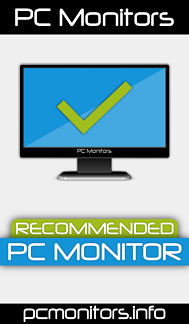
Positives Negatives The IPS-type panel and decent DCI-P3 coverage provided strong consistency and good vibrancy, with good potential for work within both the sRGB and DCI-P3 colour spaces
Gamma didn’t track the ‘2.2’ curve well ‘out of the box’ (‘Black Stabilization’ to the rescue), no sRGB emulation setting and limited Adobe RGB and Rec. 2020 coverage Decent static contrast close to specifications or slightly above depending on settings, a ‘relatively light’ matte anti-glare screen surface provided good glare handling without strong graininess Static contrast not as strong as some IPS offerings, a moderate but expected level of ‘IPS glow’ ate away at depth and atmosphere, HDR support is very basic (as expected for models of this price) Convincing 165Hz performance with exceptionally low input lag, well-tuned pixel responses and good VRR performance with ‘single overdrive mode experience’ Minor weaknesses in pixel responsiveness for some transitions, 180Hz overclock blocks off VRR (though difference vs. 165Hz is negligible) A decent pixel density and ‘desktop read estate’ from the QHD resolution, good ergonomics, reasonably feature-rich OSD and attractive pricing Limited connectivity options compared to some models and OSD not as intuitive or flexible as it could be



